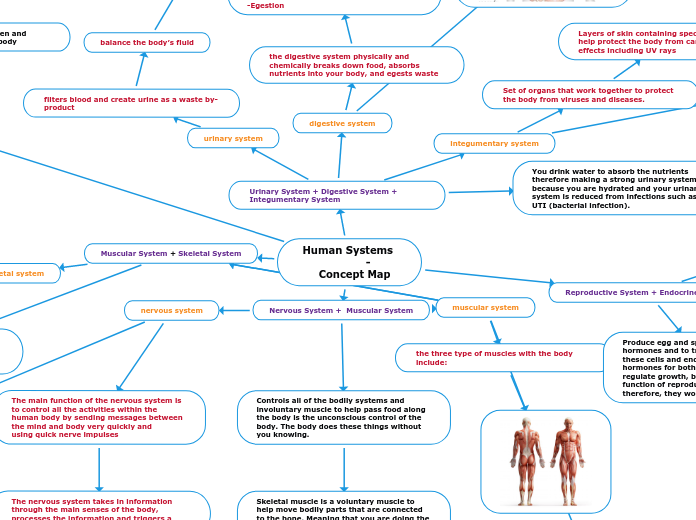av abitha selvakumar 3 år siden
463
Human Systems - Concept Map

av abitha selvakumar 3 år siden
463

Mer som dette
The circulatory system is working with the respiratory system
Right ventricle pushes blood through the pulmonary valve into the pulmonary artery allowing the lungs to receive blood for oxygen.
This connects back to the circulatory and respiratory system because the right ventricle’s duty is to pump blood through the pulmonary valve into the pulmonary artery where it receives blood and oxygen.
Gas exchange
Breathing ( movement of air)
Heart sends oxygenated blood through the arteries back to the body
Veins carry deoxygenated blood to the heart to repeat the process
Also includes the development of the brain and biological processes
Estrogens are for female development including the ovaries
The reproductive systems are divided into two parts that have individual tasks. The primary system produces the egg, sperm and hormone cells. The secondary or accessory glands hold other reproductive glands
To keep the reproductive system working efficiently, one should maintain a healthy lifestyle. This includes having a proper diet, healthy body weight, enough sleep and reducing stress. One should also quit smoking and get regular check ups
It protected the organ inside the body such as the heart,lungs and brain
It allows your body to move
Layers of skin containing specialized cells to help protect the body from carcinogenic effects including UV rays
Sweat glands that secrete waste and regulate body temperature
the six things that are part of the digestive system are: -The mouth -Swallowing -The stomach -The small intestine -The large intestine -Egestion
balance the body’s fluid
release hormones to control blood pressure
The nervous system takes in information through the main senses of the body, processes the information and triggers a reaction depending on the situation
Simple ways to keep the nervous system working effectively is to exercise daily, get enough sleep, add meditation into your routine, and stay hydrated
Cardiac muscle- works to supply blood throughout the entire body. The brain signals adapt the rate of contraction, the cardiac muscle triggers by itself to contract.
Smooth muscle- in the intestines, stomach and main organs. Involuntary muscle to help pass food along the body
Skeletal muscle- voluntary muscle to help move bodily parts that are connected to the bone.